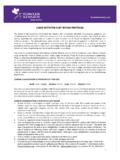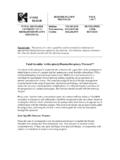Transcription of REVERSE SHOULDER ARTHROPLASTY
1 William J. Robertson, MD. UT Southwestern Orthopedics 1801 Inwood Rd. Dallas, TX 75390-8882. Office: (214) 645-3300. Fax: (214) 3301. REVERSE SHOULDER ARTHROPLASTY . The SHOULDER is a ball and socket joint that enables you to raise, twist, bend and move your arms forward, to the sides and behind you. The head of the upper arm bone (humerus) is the ball and a circular depression (glenoid) in the SHOULDER bone (scapula) is the socket. A. soft tissue rim (labrum) surrounds and deepens the socket. The head of the upper arm bone is coated with a smooth, durable, covering (articular cartilage) and the joint has a thin, inner lining (synovium) for smooth movement.
2 The surrounding muscles and tendons provide stability and support. In an arthritic SHOULDER the normal cartilage is worn away and there is bone-on-bone without the normal smooth gliding surfaces which are able to glide on one another with little friction and wear. The joint may also become irregular from bony growth (osteophytes) which is the body's attempt to heal the cartilage injury. Pain is usually due to the irregular joint surfaces rubbing on one another and from the inflammation of this wear and tear. Many people know someone with an artificial knee or hip joint. Less common, but just as successful in relieving joint pain is a SHOULDER replacement ( ARTHROPLASTY ).
3 Conventional SHOULDER replacement surgery replaces damaged joint surfaces with artificial parts (prostheses). Usually there are two components: The humeral component replaces the head of the upper arm bone, while the glenoid component replaces the socket (the glenoid depression). In the case of certain types of arthritis there can also be loss of the rotator cuff tendons. These are tendons which encircle the humeral head (ball) and help to keep the humeral head in the glenoid (socket) when the arm is elevated. These tendons also help to rotate the humerus on the glenoid so the arm can be raised. Without normal function of the rotator cuff the humeral head may move upward out of the glenoid socket and it is then difficult or impossible to raise the arm up.
4 If a conventional SHOULDER replacement is used in this situation, though there may be some pain relief, the humeral head usually remains upward rehabilitation AFTER REVERSE SHOULDER ARTHROPLASTY . out of the socket, and elevation of the arm is impossible. The Inverse SHOULDER Replacement changes the orientation of the SHOULDER so that the normal socket (glenoid) now is replaced with an artificial ball, and the normal ball is replaced with an implant that has a socket into which the artificial ball rests. This type of replacement corrects the arthritis by replacing the worn out joint surfaces with an artificial joint made of metal (cobalt chrome) and plastic (polyethylene).
5 Reversing the ball and socket changes the mechanics of the SHOULDER in order to improve active range of motion and strength. This is because the force of the deltoid is increased by moving the center of rotation of the joint inward (medially) and downward (inferiorly). The result is the patient can raise his or her arm higher and sometimes even overhead. This SHOULDER implant has been used in Europe for nearly 15 years. While the experience there has been very successful, complications have been reported. Most patients report minimal or no pain after surgery and most are able to raise the arm much higher than before surgery. The complication rate, however, is about 20%.
6 Complications can include the following: Infection Instability of the joint replacement Fracture of either the humerus or glenoid bone Nerve injury Loosening of the joint replacement Anesthesia problems Hematoma or blood clots Postoperative Instructions You will wake up in the operating room with a sling in place. You should continue to apply ice to your SHOULDER to reduce pain and swelling. Pain is usually controlled for the first 24 hours with intravenous narcotic medications through a patient controlled anesthesia (PCA) machine. This machine delivers the pain medication to you when you push a button. Alternatively, a pain catheter may be placed by our anesthesia team to help control post-operative pain.
7 Afterwards you will be transitioned to oral pain medications. While a blood transfusion is rare, it is occasionally necessary. You may be discharged home on either the first or second postoperative day. You will need someone to assist you at home, so family should be aware that you will need help with simple daily living chores such as dressing, cooking, and feeding yourself. In some instances it is necessary to go to a supervised rehabilitation facility for a period of time until you can begin effectively using your arm. rehabilitation AFTER REVERSE SHOULDER ARTHROPLASTY . Activities and advice for in the hospital and while at home: 1.
8 Please call with any concerns: 214-645-3300. 2. Apply ice to the SHOULDER as it will be quite helpful. After two days, you can change the dressing to a smaller one to allow the cold to better get to the SHOULDER . 3. Remove the sling on the first day after surgery. Move your elbow, wrist, hand and finger several times a day. Begin the pendulum exercises several times a day. Put the sling back on when you're done with these exercises. 4. After two days it is okay to shower but do not get the wound wet for at least two weeks after surgery. Keep it covered with plastic wrap while showering. Do not submerge the wound as you would in a bath tub or hot tub for at least 4 weeks after surgery.
9 To wash under your operated arm bend over at the waist and let the arm passively swing away from the body. It is safe to wash under the arm in this position. 5. After SHOULDER surgery there is a variable amount of pain and swelling. This will dissipate after several days. Continue to take the pain medicine you were prescribed as needed. 6. It is important to look out of signs of infection following joint replacement surgery. These can include: fever (temperature > , chills, nausea, vomiting, diarrhea, redness around your incision, or yellow or green drainage from your incision. Should any of these be present please contact Dr. Robertson's office.)
10 7. You will need to take prophylactic antibiotics before dental procedures, colonoscopies or other invasive procedures. This consists of Amoxicilin (2 grams one hour prior to your procedure), or if you have a penicillin allergy you should take Clindamycin (600mg one hour prior to procedure). Your dentist or Dr. Robertson can prescribe this. 8. You will have an office visit scheduled approximately 10-14 days after your surgery. At that visit you will see Dr. Robertson and one of his physical therapist who will go over exercises and restrictions with you. If you do not have a follow-up appointment schedule please call the office and make one.







